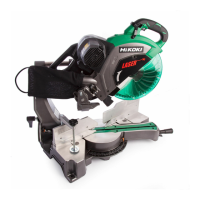12
SPECIFICATIONS
Max.
sawing
dimension
Head Turntable Max. sawing dimension
Miter 0 0 Max. Height
Max. Width
105 mm
312 mm
0 Left 45°
or
Right 45°
Max. Height
Max. Width
105 mm
220 mm
0 Right 57° Max. Height
Max. Width
105 mm
170 mm
Bevel Left 45° 0 Max. Height
Max. Width
68 mm
312 mm
Right 45° 0 Max. Height
Max. Width
43 mm
312 mm
Compound Left 45° Left 45° Max. Height
Max. Width
68 mm
220 mm
Left 45° Right 31° Max. Height
Max. Width
68 mm
265 mm
Right 45° Right 45° Max. Height
Max. Width
43 mm
220 mm
Right 45° Left 31°
Max. Height
Max. Width
43 mm
265 mm
Saw Blade Dimensions (oD × iD × Thickness) 305 mm × 25.4 mm × 2.3 mm
Miter Cutting Angle Right 0° – 57°, Left 0° – 45°
Bevel Cutting Angle Right 0° – 45°, Left 0° – 45°
Compound Cutting Angle
Bevel (Left) 0° – 45° Miter (Left) 0° – 45°, (Right) 0° – 31°
Bevel (Right) 0° – 45° Miter (Right) 0° – 45°, (Left) 0° – 31°
Voltage (by areas)*
230 V, 240 V
Power Input* 1520 W
No-Load Speed 4000 /min
Machine Dimensions (Width × Depth × Height) 655 mm × 890 mm × 724 mm
Weight (Net) 27 kg
Laser Marker
Maximum output Po<0.4 mW Class 1M Laser Product
(Iambda) 650 nm
Laser medium Laser Diode
* Be sure to check the nameplate on product as it is subject to change by areas.
STANDARD ACCESSORIES
○ 305 mm TCT Saw blade (mounted on tool) ...................1
○ Dust bag .......................................................................1
○ 17 mm Box wrench .......................................................1
○ Vise Assembly ..............................................................1
○ Holder ...........................................................................1
○ Side Handle (mounted on tool) .....................................1
○ Sub Fence (mounted on tool) ........................................1
○ Washer (C) (Only For Australia) ....................................1
Standard accessories are subject to change without notice.
APPLICATION
Cutting various types of aluminium sash and wood.
PRIOR TO OPERATION
CAUTION
Make all necessary adjustments before inserting the
plug in the power source.
1. Power source
Ensure that the power source to be utilized conforms
to the power requirements specifi ed on the product
nameplate.
Do not use with direct current, or transformers such as
boosters. Doing so may result in damage or accidents.
2. Power switch
Ensure that the power switch is in the OFF position. If the
plug is connected to a receptacle while the trigger switch
is in the ON position, the power tool will start operating
immediately, inviting serious accident.
3. Extention cord
When the work area is removed from the power source,
use an extension cord of suffi cient thickness and rated
capacity. The extension cord should be kept as short as
practicable.
4. Remove all packing materials attached or
connected to the tool before attempting to operate
it.
5. Releasing the locking pin (Fig. 3)
When the power tool is prepared for shipping, its main
parts are secured by a locking pin.
Move the handle slightly so that the locking pin can be
disengaged.
During transport, lock the locking pin into the gear case.
6. Attach the dust bag to the main unit (Fig. 1)
7. Installation (Fig. 4)
Ensure that the machine is always fi xed to bench.
Attach the power tool to a level, horizontal work bench.
Select 8 mm diameter bolts suitable in length for the
thickness of the work bench.
Bolt length should be at least 40 mm plus the thickness
of the work bench.
For example, use 8 mm × 65 mm bolts for a 25 mm thick
work bench.
0000BookC12RSH2.indb120000BookC12RSH2.indb12 2016/03/1015:56:562016/03/1015:56:56

